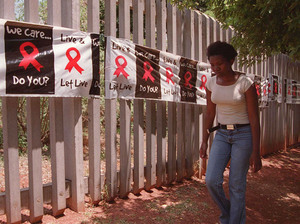viaNPRbooks
"In vaginal sex, you can have sex with hundreds of people and not transmit [HIV], it turns out," he says. "And that's part of the reason it's still with us today. It has spread very slowly. It makes people ill very slowly. ... And that's one of the reasons why it's been so difficult for the world to understand it. ... It's been hard to make sense of this epidemic because of the way it moves. It's not obvious."
The History Of HIV
Timberg tells Fresh Air's Dave Davies that the simian version of HIV — which is called SIV — has been around for thousands of years. It was only when colonial powers migrated across parts of Africa — where the SIV virus existed among the chimps — that the virus started to spread among humans.
"It was only with the introduction of these new transport routes, of these human movements, that HIV popped out of the chimpanzee population and starts an epidemic among the human population and became what we see today," he says.
In the past 100 years, 99 percent of all of the world's deaths from AIDS have come from a strain of the virus called HIV-1 group M, which first appeared in remote parts of Cameroon, where African porters worked a century ago cutting paths across dense brush in places where humans had never before traveled.
"The best theory is that a human caught a chimp, was butchering a chimp — which is a very bloody business — and in the process of that cut his hand, and the virus mutated as it went into the human bloodstream," says Timberg. "... [There was] human movement in areas where humans didn't live in great density before colonialism arrived — you had the arrival of the rubber trade and the ivory trade, and suddenly you had to go into these very deep parts of the forest that were not hospitable to humans before and since."
From Cameroon, strains of HIV migrated down into other parts of central Africa and then into Leopoldville, which is now called Kinshasa. Leopoldville was a Belgian territory and by 1920 had become the capital of the Belgian Congo — complete with factories, shipyards, railways and single-sex dormitories for the workers, who were thrust into urban living conditions.
"You had the kind of human movement that could really get an epidemic moving," says Timberg.
In 1960, the Belgians gave up Congo, which then became an independent country again. At that point, 1,000 to 2,000 people likely had HIV, says Timberg.
"But you have to bear in mind, when HIV progresses into AIDS, it looks like a lot of other diseases," he says. "You have diarrhea, you have fevers, you have wasting. So there's not much evidence that anybody at the time had any evidence that there was a new sickness."
The unknowingly infected inhabitants of Kinshasa mingled with U.N. aid workers who were flown over from Haiti to work as physicians and civil servants. It is almost certainly the case, says Timberg, that one of the Haitian aid workers caught HIV in Leopoldville and then flew back to Haiti.
Fighting AIDS In Africa
In the 1980s in the United States, there was a large resistance to the idea that HIV and AIDS could spread widely among a heterosexual population — in part, says Timberg, because it didn't happen in many places. But across Africa, he says, it was a different story.
"The first researchers who began to look into the HIV epidemic in Africa found these unbelievable rates of infection that frankly horrified them and terrified them," he says. "When they began to write their papers about this, the peer-reviewed medical journals were like, 'You're crazy. You can't have HIV spreading like this.' But in Africa, it did."
Many African countries initially ignored the AIDS crisis, but some nations — like Uganda and Zimbabwe — were successful in providing public health information and slowing the spread of the disease. Timberg says when Western countries later became serious about fighting the African AIDS epidemic, international AIDS groups didn't follow Uganda's model — and overlooked some relatively simple and inexpensive approaches proven to stem the spread of HIV.
One of their errors, he says, was overlooking the effectiveness of male circumcision. Circumcised men are at a much lower risk of becoming infected with HIV through sexual transmission.
"When you look at the parts of not just Africa but the world where HIV is worse, it is almost inevitably societies that don't circumcise," he says. "The science on this began emerging in the 1980s and it became terribly politicized. People were uncomfortable with the subject, and the whole discussion became incredibly controversial. It took almost 20 years for the scientific community and the community of policymakers to really do enough science and enough research to realize how important this was."
Read the Rest.
[Content that is linked from other sources is for informational purposes and should not construe a Mapping Pathways position.]


No comments:
Post a Comment